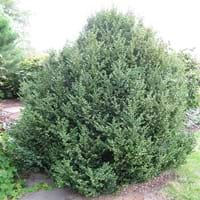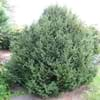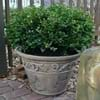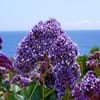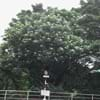Life Span
Perennial
Perennial
Type
Broadleaf Evergreen
Fruit
Origin
Hybrid origin
China
Types
Not Available
Actinidia deliciosa chlorocarpa, Actinidia deliciosa deliciosa
Number of Varieties
Not Available
Habitat
hedge rows, Shady Edge, Woodland Garden Dappled Shade
Mountain forests
USDA Hardiness Zone
6-9
6-9
AHS Heat Zone
Not Available
9-7
Sunset Zone
21,22
4, 5, 6, 7, 8, 9, 12, 14, 15, 16, 17, 18, 19, 20, 21, 22, 23, 24
Habit
Pyramidal
Vining/Climbing
Minimum Width
Not Available
Flower Color
Light Yellow
Light Yellow, Ivory
Flower Color Modifier
Bicolor
Bicolor
Fruit Color
Not Available
Tan, Brown
Leaf Color in Spring
Green, Dark Green
Green, Light Green
Leaf Color in Summer
Dark Green
Green
Leaf Color in Fall
Dark Green
Light Green, Yellow green
Leaf Color in Winter
Dark Green
Light Green
Leaf Shape
Pinnate
Heart-shaped
Plant Season
Spring, Summer, Fall, Winter
Spring, Summer, Fall
Sunlight
Full Sun, Partial Sun
Full Sun, Partial Sun
Type of Soil
Loam, Sand
Clay, Loam
The pH of Soil
Acidic, Neutral
Acidic, Neutral
Soil Drainage
Well drained
Average
Bloom Time
Spring
Late Spring, Early Summer
Tolerances
Pollution
Drought
Where to Plant?
Container, Ground, Pot
Ground
How to Plant?
Root Division, Stem Cutting
Layering, Softwood cuttings
Plant Maintenance
Medium
Medium
Watering Requirements
Needs more water during establishment, Never Over-water, occasional watering once established
Water daily during growing season
In Summer
Lots of watering
Lots of watering
In Spring
Moderate
Moderate
In Winter
Average Water
Average Water
Soil pH
Acidic, Neutral
Acidic, Neutral
Soil Type
Loam, Sand
Clay, Loam
Soil Drainage Capacity
Well drained
Average
Sun Exposure
Full Sun, Partial Sun
Full Sun, Partial Sun
Pruning
Prune ocassionally, Remove branches, Remove branches that rub together, Remove crossing or rubbing branches, Remove damaged leaves, Remove dead branches, Remove dead leaves, Remove dead or diseased plant parts
Prune for shortening long shoots, Prune in early summer, Prune in late winter
Fertilizers
All-Purpose Liquid Fertilizer, Fertilize in early to mid-summer
Self-fertile
Pests and Diseases
Red blotch
Armillaria root rot, Armored scales, Bleeding canker, Botrytis Blight, Crown gall, Nematodes, Phytophthora Root Rot, Red blotch
Plant Tolerance
Pollution
Drought
Flower Petal Number
Single
Single
Foliage Texture
Fine
Medium
Foliage Sheen
Glossy
Matte
Attracts
Bees, Birds
Not Available
Allergy
Poisonous
Inflammation, Mouth itching, Throat itching
Aesthetic Uses
Used for making hedges
Not Used For Aesthetic Purpose
Beauty Benefits
Not Available
Beautiful Skin, Protects from sun damage
Environmental Uses
Air purification
Air purification
Medicinal Uses
Alterative, Antirheumatic, Arthritis, cathartic, Cholagogue, Detoxification, Diaphoretic, Febrifuge, HIV/AIDS, Homeopathy, Immunity, Odontalgic, Sedative, Tonic, Vermifuge
constipation, Heart problems, Low Blood Pressure
Part of Plant Used
Flowers, Leaves, Wood
Fruits
Other Uses
Used as a dye, Used for woodware
Used As Food, Used for its medicinal properties
Used As Indoor Plant
Yes
No
Used As Outdoor Plant
Yes
Yes
Garden Design
Container, Edging, Feature Plant, Foundation, Hedges, Mixed Border
Edible, Fruit / Fruit Tree, Rock Garden / Wall, Vine
Botanical Name
BUXUS 'Green Mountain' COPF
ACTINIDIA deliciosa
Common Name
Boxwood, Green Mountain Boxwood
Chinese Gooseberry, Fuzzy Kiwi, Kiwi
In Hindi
Buxus Green Mountain Tree
कीवी फल
In German
Buxus Green Mountain Baum
Kiwi, Chinesischer Strahlengriffel
In French
Buxus Green Tree Montagne
Kiwi, Groseille de Chine, Yang Tao, Souris végétale
In Spanish
Buxus árbol verde de la montaña
kiwi, kivi, actinidia
In Greek
Buxus Green Mountain Tree
Ακτινίδια
In Portuguese
Buxus Árvore verde da montanha
Quiuí
In Polish
Buxus Green Mountain Drzewo
Owoc kiwi
In Latin
Buxus Viridis ligno
Kiwi fructum
Phylum
Magnoliophyta
Magnoliophyta
Class
Magnoliopsida
Magnoliopsida
Order
Euphorbiales
Ericales
Family
Buxaceae
Actinidiaceae
Clade
Angiosperms, Eudicots
Angiosperms, Asterids, Eudicots
Tribe
Not Available
Not Available
Subfamily
Not Available
Not Available
Importance of Buxus Green Mountain and Kiwifruit
Want to have the most appropriate plant for your garden? You might want to know the importance of Buxus Green Mountain and Kiwifruit. Basically, these two plants vary in many aspects. Compare Buxus Green Mountain and Kiwifruit as they differ in many characteristics such as their life, care, benefits, facts, etc. Every gardener must at least have the slightest clue about the plants he wants to plant in his garden. Compare their benefits, which differ in many ways like facts and uses. The medicinal use of Buxus Green Mountain is Alterative, Antirheumatic, Arthritis, cathartic, Cholagogue, Detoxification, Diaphoretic, Febrifuge, HIV/AIDS, Homeopathy, Immunity, Odontalgic, Sedative, Tonic and Vermifuge whereas of Kiwifruit is constipation, Heart problems and Low Blood Pressure. Buxus Green Mountain has beauty benefits as follows: Not Available while Kiwifruit has beauty benefits as follows: Not Available.
Compare Facts of Buxus Green Mountain vs Kiwifruit
How to choose the best garden plant for your garden depending upon its facts? Here garden plant comparison will help you to solve this query. Compare the facts of Buxus Green Mountain vs Kiwifruit and know which one to choose. As garden plants have benefits and other uses, allergy is also a major drawback of plants for some people. Allergic reactions of Buxus Green Mountain are Poisonous whereas of Kiwifruit have Inflammation, Mouth itching and Throat itching respectively. Having a fruit bearing plant in your garden can be a plus point of your garden. Buxus Green Mountain has no showy fruits and Kiwifruit has no showy fruits. Also Buxus Green Mountain is flowering and Kiwifruit is not flowering . You can compare Buxus Green Mountain and Kiwifruit facts and facts of other plants too.
